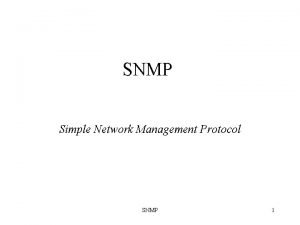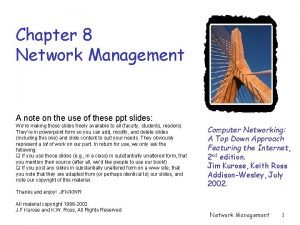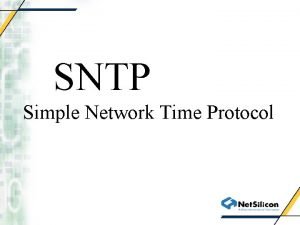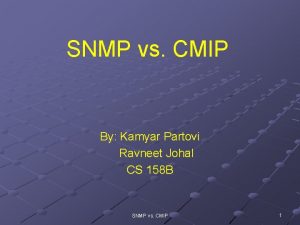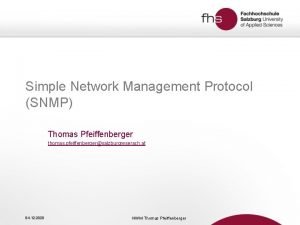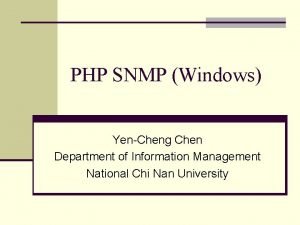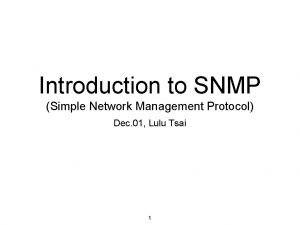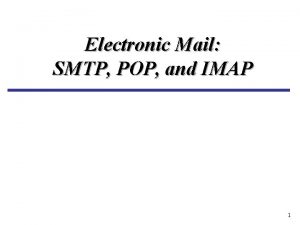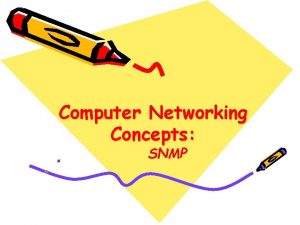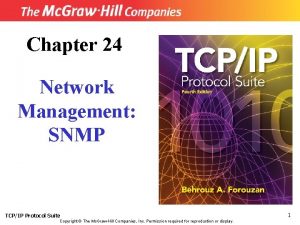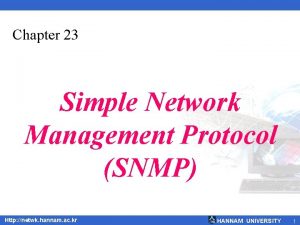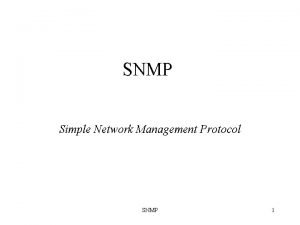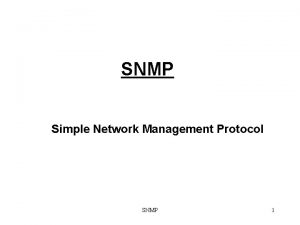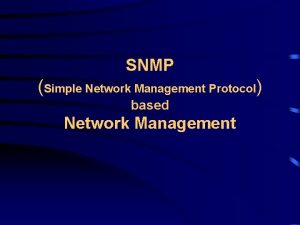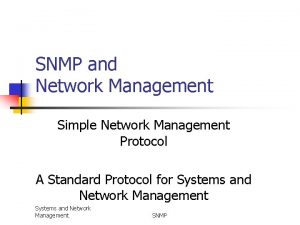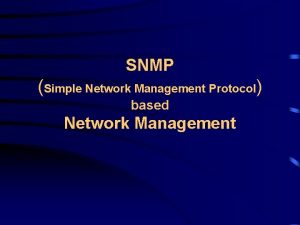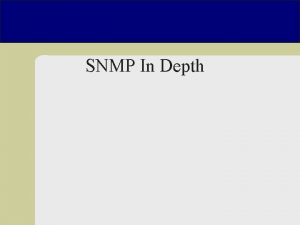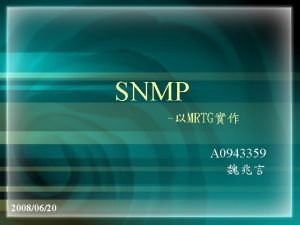SNMP Simple Network Management Protocol Simple Network Management
















- Slides: 16

SNMP Simple Network Management Protocol

Simple Network Management Protocol • SNMP is a framework that provides facilities for managing and monitoring network resources on the Internet. • Components of SNMP: – SNMP agents – SNMP managers – Management Information Bases (MIBs) – SNMP protocol itself

Simple Network Management Protocol • SNMP agent is software that runs on a piece of network equipment (host, router, printer, or others) and that maintains information about its configuration and current state in a database • Information in the database is described by Management Information Bases (MIBs) • An SNMP manager is an application program that contacts an SNMP agent to query or modify the database at the agent. • SNMP protocol is the application layer protocol used by SNMP agents and managers to send and receive data.

SNMP • Interactions in SNMP

MIBS • A MIB specifies the managed objects • MIB is a text file that describes managed objects using the syntax of ASN. 1 (Abstract Syntax Notation 1) • ASN. 1 is a formal language for describing data and its properties • In Linux, MIB files are in the directory /usr/share/snmp/mibs – Multiple MIB files – MIB-II (defined in RFC 1213) defines the managed objects of TCP/IP networks

Managed Objects • Each managed object is assigned an object identifier (OID) • The OID is specified in a MIB file. • An OID can be represented as a sequence of integers separated by decimal points or by a text string: Example: – 1. 3. 6. 1. 2. 1. 4. 6. – iso. org. dod. internet. mgmt. mib-2. ip. Forw. Datagrams • When an SNMP manager requests an object, it sends the OID to the SNMP agent.

Organization of managed objects • Managed objects are organized in a tree-like hierarchy and the OIDs reflect the structure of the hierarchy. • Each OID represents a node in the tree. • The OID 1. 3. 6. 1. 2. 1 (iso. org. dod. internet. mgmt. mib-2) is at the top of the hierarchy for all managed objects of the MIB-II. • Manufacturers of networking equipment can add product specific objects to the hierarchy.

Definition of managed objects in a MIB • Specification of ip. Forw. Datagrams in MIB-II. ip. Forw. Datagrams OBJECT-TYPE SYNTAX Counter ACCESS read-only STATUS mandatory DESCRIPTION "The number of input datagrams for which this entity was not their final IP destination, as a result of which an attempt was made to find a route to forward them to that final destination. In entities which do not act as IP Gateways, this counter will include only those packets which were Source-Routed via this entity, and the Source. Route option processing was successful. " : : = { ip 6 }

SNMP Protocol • SNMP manager and an SNMP agent communicate using the SNMP protocol – Generally: Manager sends queries and agent responds – Exception: Traps are initiated by agent.

SNMP Protocol • • • Get-request. Requests the values of one or more objects Get-next-request. Requests the value of the next object, according to a lexicographical ordering of OIDs. Set-request. A request to modify the value of one or more objects Get-response. Sent by SNMP agent in response to a getrequest, get-next-request, or set-request message. Trap. An SNMP trap is a notification sent by an SNMP agent to an SNMP manager, which is triggered by certain events at the agent.

Traps • Traps are messages that asynchronously sent by an agent to a manager • Traps are triggered by an event • Defined traps include: – link. Down: Even that an interface went donw – cold. Start - unexpected restart (i. e. , system crash) – warm. Start - soft reboot – link. Up - the opposite of link. Down – (SNMP) Authentication. Failure –…

SNMP Versions • Three versions are in use today: – SNMPv 1 (1990) – SNMPv 2 c (1996) • Adds “Get. Bulk” function and some new types • Adds RMON (remote monitoring) capability – SNMPv 3 (2002) • SNMPv 3 started from SNMPv 1 (and not SNMPv 2 c) • Addresses security • All versions are still used today • Many SNMP agents and managers support all three versions of the protocol.

Format of SNMP Packets • SNMPv 1 Get/Set messages: Cleartext string that is used as a password PDU type, e. g. : 32: SNMPv 1 Get 64: SNMPv 2 Get Unique ID to match requests with replies Sequence of name-value pairs

SNMP Security • SNMPv 1 uses plain text community strings for authentication as plain text without encryption • SNMPv 2 was supposed to fix security problems, but effort derailed (The “c” in SNMPv 2 c stands for “community”). • • SNMPv 3 has numerous security features: – Ensure that a packet has not been tampered with (integrity), – Ensures that a message is from a valid source (authentication) – Ensures that a message cannot be read by unauthorized (privacy).

SNMP Security • Security model of SNMPv 3 has two components: 1. Instead of granting access rights to a community, SNMPv 3 grants access to users. 2. Access can be restricted to sections of the MIB (Versionbased Access Control Module (VACM). Access rights can be limited • by specifying a range of valid IP addresses for a user or community, • or by specifying the part of the MIB tree that can be accessed.

Security levels in SNMPv 2 SNMP has three security levels: • no. Auth. No. Priv: Authentication with matching a user name. • auth. No. Priv: Authentication with MD 5 or SHA message digests. • auth. Priv: Authentication with MD 5 or SHA message digests, and encryption with DES encryption Compare this to SNMPv 1 and SNMPv 2 c: • SNMPv 1, SNMPv 2: Authentication with matching a community string.
 Snmp model in computer networks
Snmp model in computer networks Arquitectura snmp
Arquitectura snmp Simple network management protocol ppt
Simple network management protocol ppt Simple ntp
Simple ntp Ravneet johal
Ravneet johal Getresponse snmp
Getresponse snmp Snmp mib2
Snmp mib2 Snmp-architektur
Snmp-architektur Php snmp example
Php snmp example Snmp
Snmp Snmp traffic grapher
Snmp traffic grapher Lulu tsai md
Lulu tsai md Snmp vs smtp
Snmp vs smtp Snmp stands for
Snmp stands for Snmp uses two other protocols -------- and --------
Snmp uses two other protocols -------- and -------- Snmp ports
Snmp ports Cacti snmp trap
Cacti snmp trap

